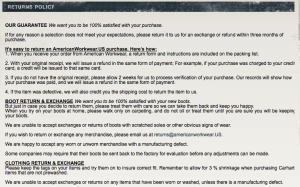
The Complaint Handling Process online

Last week we took the customers’ perspective and focused on complaint handling online in Denmark. In this article, we will take a look at the online complaint handling process and policies elsewhere. What is the balance between costs and customer loyalty? And can the Danish webshops learn something, or is it the other way around? We will look at cases from the UK, the U.S. and Canada.
Costs are considered more important than customer loyalty
In last week’s Danish cases about complaint handling procedures at online workwear stores, we saw a tendency to prioritise cost reduction above customer service. Is this an international tendency? Or is it specific to Danish companies? We have searched for foreign complaint handling processes and policies in the workwear industry. Here’s what we found.
Cases on the online complaint handling process and policy
Case #1: High expectations about great service
The first-hand impression from the American webshop whistleworkwear.com is one of an excellent service level. On the front page, the company promotes a plus 19-year long experience on the market with thousands of loyal customers. The complaint handling process is combined with the company’s return policy:
Americanworkwear.com explains in their return policy that items that do not meet the customers’ expectations can be returned or exchanged within three months of purchase. Furthermore, they accept returns of any item with a manufacturing defect and they will even credit the customers’ shipping costs. This is more than what we found in Denmark.
If a customer wants to return, exchange or file a complaint then the customer only needs to fill in the returns form, follow the instructions included on the packing list or email americanworkwear.com. This is simpler than the policies of the Danish stores, where a lot more work was required by the customer. Reducing the length of the complaint handling process for the customer may mean more work on the receiving end. This leaves this reviewer with the feeling that americanworkwear.com would like to receive a complaint and help their customers’ to be – in their own words – 100% satisfied with your purchase. So far so good.
Case #2: A complaint handling process that obligates
The British webshop dickiesstore.co.uk sells the brand Dickies to the UK workwear market. In this case, they also combined returns with the complaint handling process:
As the text in the screen capture above illustrates, there is no specific description of the complaint handling process – only that you as a customer need to call or email Dickie’s customer service and that all shipping costs related to the complaint are refundable.
This type of complaint handling process can from a customer perspective be experienced as simple, since there only is one step – contact customer service. However, this raised further questions for the customer who may feel uncertain about the professionalism of the procedure: How can I get my money back? How long will it take to process the complaint? What kind of documentation do I need to provide to ensure a positive outcome?
Experienced online buyers are used to finding all necessary information online and independently execute and fulfil returns and complaints without contacting customer service. Therefore this procedure may appear time-consuming, compared to an online procedure. To accommodate the customers’ needs and give the impression of professionalism, this procedure obligates the customer service to provide the customers with a great and quick service to maintain customer loyalty.
Case #3: Uncertainty requires contact with customer service
The Canadian webshop All Safety Gear sells high-quality construction and safety products.

As seen above All Safety Gear guarantees that their products have no manufacturing defects and they accept to refund or exchange any defective item. But where do you find the complaint procedure if you are unlucky and do receive a defect product despite the assurance? I found the procedure via the link to Policies:
The customer should contact customer service by email or phone within 30 days. However what if a defect only shows after six months of use? Furthermore, the original box, manual, warranty card, etc. must be returned with the defective product. However, a lot of customers will no longer have this since the product is in use.
There are some uncertainties in this complaint handling process. The specific procedure is not transparent to the customer. Plus, the requirement that the original box, manual, etc. will put off customers. This forces the customer to contact customer service for further information. Compared with case #2 this type of procedure is beneficial for the company as they through the contact to customer service can get some unique insights into the customer and the problem. But it is also a procedure that requires a great and efficient service and the customer to take action and contact the customer service.
Responsibility and tendencies
From these three cases, I see a tendency in online complaint handling – the customer must contact customer service as one of the first steps to report a complaint and a defective item. This provides the companies with unique insights into the customers and the types of errors they receive. However, it is also a procedure that obligates the companies to provide their customers with an effective and great service.
These cases from the UK, U.S. and Canada seem simple and easy for the customer. The companies take responsibility for the complaint and the process – it only requires the customer to contact customer service. In the Danish cases from last week, the procedures are a bit different as the customer independently can execute the procedure without requiring contact with customer service. A procedure that is quick, efficient and flexible for the customer to handle online.
The question is whether last week’s cases about Danish webshops on the workwear market, could learn from these foreign procedures to provide an exceptional experience and a deeper insight to improve their products and customer’s loyalty? Or is it the foreign companies who should learn from the Danish, to achieve a more efficient and low-cost process for complaint handling?
Frequently Asked Questions
While the initial response to an online complaint usually comes within 24-48 hours, the full resolution may take a few days to weeks, depending on the complexity of the issue.
The handling process varies for minor and complex complaints. Minor issues follow a routine process of acknowledgement, investigation, and resolution. For complex matters, the process might include involvement from higher management or legal consultations.
To protect the complainant’s privacy during the complaint handling process, organizations use secure communication channels, limit data access, and implement stringent data protection policies. They also regulate the storage of sensitive information with comprehensive security controls and advise complainants not to share sensitive data through unsecured means.





